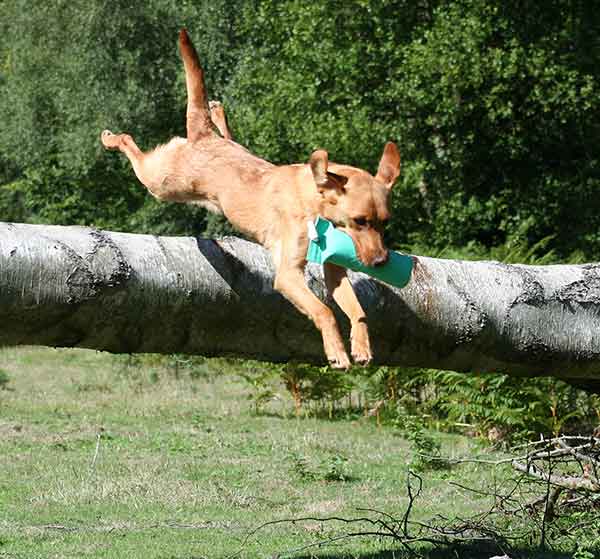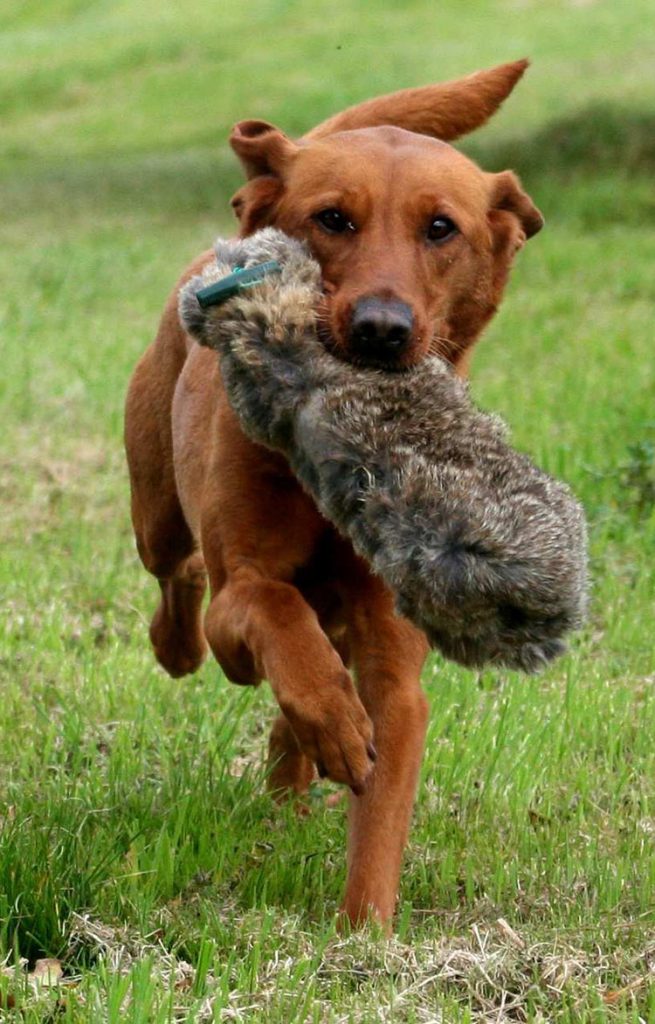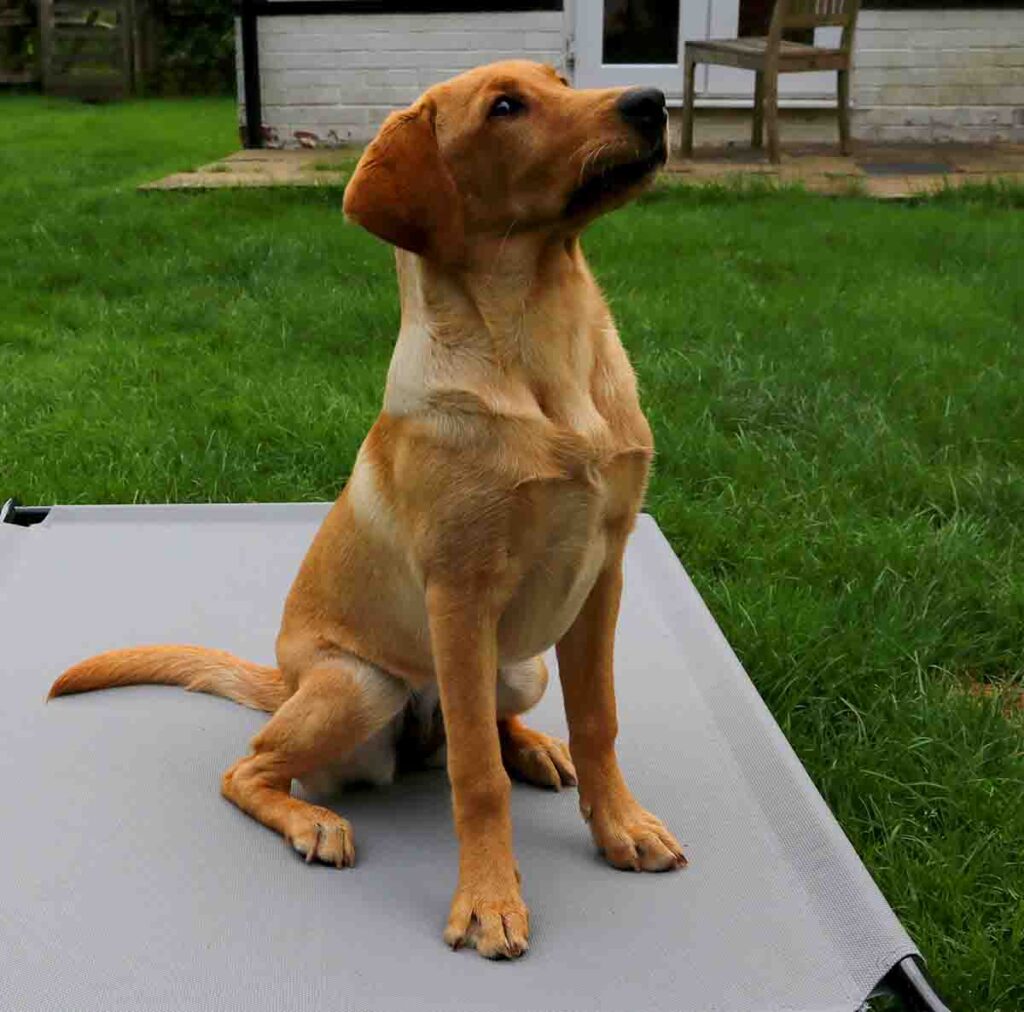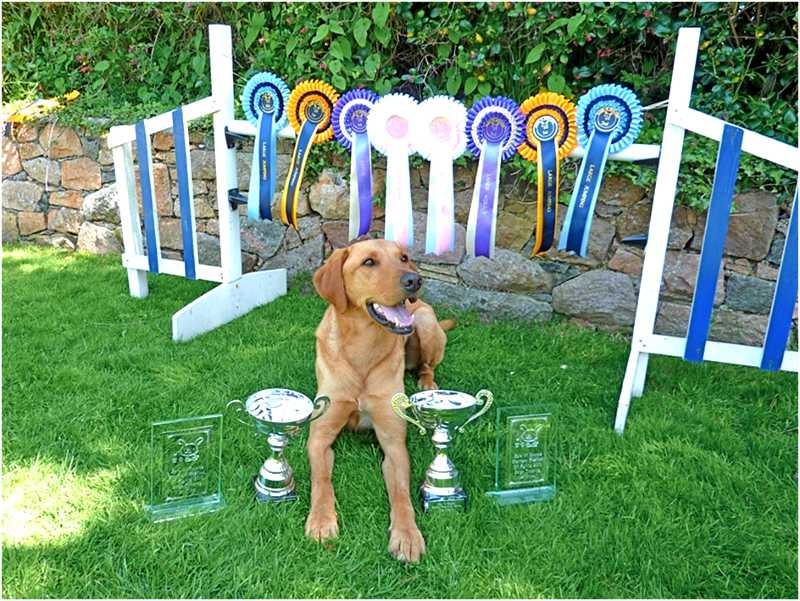American Labrador: Raising And Training A Lab From Working Lines
I have been around working retrievers for most of my life but it wasn’t until I started talking to retriever trainers in the USA that I came across the phrase American Labrador.
You hear the term used more widely now, but in the UK it’s still more common for American Labs to be referred to as working line Labradors or field bred Labs.

You can find some more information on the split between working and show lines of Labrador in this article: American Vs English Labradors, but today I want to focus on celebrating the power, intelligence and agility of the American Labrador Retriever.
I’ll talk a bit about the appearance and temperament of American Labs, and about how you can find, raise and train one of these awesome dogs.
But let’s first take a brief look at where they come from.
The original role of the working retriever
The arrival of Labradors and other retrievers, was a direct response to the development of the use of guns. When guns first came on the scene they changed the face of game hunting. And dogs became more specialised to meet the needs of the newly armed game hunter!

The first guns were cumbersome muzzle loaders and the dogs that worked to the gun were pointers and setters.
These long legged dogs would hunt vast areas and seek out individual birds, pointing them out to their human companions who could then approach within range to shoot the bird when flushed. The bag might be one or two birds.
With the advent of faster breech loading guns and the arrival of driven game shooting in the UK, a new type of dog was needed. A day’s shooting could now bag many birds at a time, and with a pair of breech loading guns and a loader, shots could be fired repeatedly.
A dog that could remain calm in the midst of such excitement and retrieve bird after bird, without disturbing the game in adjacent strips of land, was required.
And so the retriever breeds were developed and bred for this specialised job. And of course the dog that reigned supreme at this task, was our beloved Labrador Retriever. And it was these working dogs that were exported to the USA to form the foundations of all the lines of both field and show labs that you see there today.
It’s worth noting that this is a breed that has made the transatlantic journey several times in their history. The first Labs were bred from St Johns Water dogs imported from Newfoundland having originally been taken there from the UK by emigrating fishermen! You can read more about the history of the breed by following this link: Origins And History Of The Labrador Retriever.
The modern field Labrador
On arriving in the USA, the Labrador Retriever rapidly became a popular hunting companion, but the passion for exhibiting dogs in the show ring was growing in popularity as it was in the UK. The breed soon became split on both sides of the atlantic into Field and Show lines, and in the USA these two divisions acquired their popular names of American and English Labradors.
The modern American Lab is built for speed. This is a lean, keen dog that looks every inch the athlete. Most will lack the heavy, blocky head that you see on Labs in the show ring, and will have longer legs and a more slender appearance overall.
Some would argue that the American Lab doesn’t meet the breed standard. This doesn’t bother their many passionate fans who are more concerned with the ability of their dogs in the field, than their ability to win a beauty pageant. They might in turn argue that the breed standard is being misinterpreted by the show dog community. It’s a debate that never grows old!
What are American Labs like?
Many Labs from working lines come from breeders that compete in Field Trials. These are competitions that test the ability of the Labrador to mark and retrieve over long distances and challenging terrain. And the features of the modern working Labrador reflect those challenges.
These are dogs that are utterly invested in co-operating with their human handler, responsive to whistles and hand signals at hundreds of yards away. And capable of persisting and pushing through tremendous challenges.
But most people are more interested in how a Lab will fit into their family life than how fast they can run or how pretty they are. And some love the look of the English Lab but want a hunting companion. So I suppose the questions we need to ask here are:
- Does the American Lab make a good pet
- Do I have to have an American Lab if I want a hunting companion
- How do I go about getting a good quality American Lab
Does the American Lab make a good pet?
The vast majority of American Labs are pets. Even and including those that compete in Field Trials. Many are able to switch off all that energy at the end of the working day and spend the evening snoozing peacefully next to their family.

So an American Lab could make a very good pet for your family with some provisos.
These dogs need a lot of exercise. Twenty minutes before you go to work will not cut it.
Nor is this a dog that can be left alone for hours at a time on a daily basis. You’ll simply end up with a destructive and/or anxious dog that is miserable.
If there’s an adult around to spend time with your Lab, and you are interested in investing time every day, most days in walking, or running with your dog. And are interested in training your dog to harness that amazing ability and intelligence. Then this could be the perfect dog for you.
Be aware that like all Labs, working line Labradors are very bouncy and clumsy when young. It can be challenging to combine a half grown Lab puppy with small children or elderly family members. Or anyone that is unsteady on their feet.
Also, all Labradors shed. And though some field bred Labs have less dense coats than their show cousins. They still shed and your home will get hairy. You may need to lower your standards, or buy a new vacuum cleaner!
Do I have to have an American Lab if I want a hunting companion?
Okay, so what if you actually like the English Lab look? Suppose you love the blocky head, and the thick otter tail. And you prefer the happy-go-lucky, “I love the neighbors and anyone else that happens to be passing”, temperament of the show line Labrador.
Can such a dog make a decent hunting companion? The answer of course is yes. Up to a point. Many show bred Labs still have wonderful retrieving instincts. And they are highly intelligent and easy to train.
The challenges often lie in the fact that they can be over-friendly. And easily distracted by other dogs and passing strangers. With good training you can get around this. But what you can’t get around is that a show bred Lab is almost certainly never going to win you a Field Trail.
The last dual champion died decades ago and Field Trials in both the USA and the UK have become so specialized that a dog that hasn’t been bred to compete in them, stands little chance.
So, in short, do you need an American Lab to train a hunting companion? No. Do you need an American Lab to win a Field Trial, or to get to a high standard in Hunt Tests? Yes.
How do I go about getting a good quality American Lab?
As always, a good puppy starts with a good breeder. Check out 8 Steps To Buying A Healthy Labrador Puppy for general guidance but you’ll need narrow your search down to dogs bred from working lines. You’ll be able to recognize a working pedigree by the titles of the dogs that have won competitions.
In show dogs these include titles such as ShCh, and GCh. What you looking for is a pedigree with some field titles on it. Some but not necessarily a lot.
In the USA you’ll see FC (field champion), GFC, NFC, AFC (amateur field champion) or NAFC on a trialling pedigree. Advanced hunt test titles include HRCH, GRHRCH, or MH
If this is the first dog you have trained, you don’t want to end up with a dog that is too hot to handle, or at least too much for you. A good breeder will be able to advise you and help you pick a dog suited to your needs and experience.
Joining a retriever club and attending some meetings is a great way to get to know your local retriever community and make contacts and connections that can lead you to a great puppy.
As with any puppy, always meet the puppy with its mother, in the breeder’s own home, and walk away from any purchase if any of the dogs on the site are aggressive or very aloof. A Labrador should be calmly (if over 2 years old) friendly and pleased to see you.
Raising and training your American Lab
The principles of training are the same for all Labradors, up to a point. So your puppy will need basic training and puppy socialization to prepare them for living among humans and ensure they can relax and be trusted wherever you take them.
You can use those links to find out more. And you can also find my puppy parenting course and basic obedience courses over on my Dogsnet website
When it comes to retriever training there are range of options depending on where you live and the job you want your Labrador to do. So let’s take a look at the different roles that working Labrador retrievers play on both sides of the atlantic.
USA vs UK Retriever Competitions
In Field Trials, dogs compete against other dogs. Field Trials in the UK have been largely unchanged for a hundred years. They are still based on the driven pheasant shooting format that our ancestors enjoyed and UK Field Trials take place under live shooting conditions on a genuine shooting day.
This means that each dog will have different types of retrieve to collect. Some will be dead marked birds, some will be blind retrieves, and some will be runners (wounded birds). No two retrieves in any field trial will be the same.
The priority of the judges are outstanding game-finding ability, soft mouth, and good manners. Noise of any kind is an eliminating fault. Dogs must be faultlessly calm and obedient.
Field trials in the USA are very different . The lack of driven pheasant shoots in America has meant that Field Trials have evolved along different lines. Each trial comprises a number of pre-planned retrieves and every dog has to carry out the same retrieves under the same conditions.
This means that if dog A has to run two hundred and fifty yards and swim a lake half way, dog B will have to do the same.
In many ways this is a much fairer assessment because the dogs have all had to complete the same task, in others it is a less natural assessment of what happens under genuine shooting conditions.
In the USA there is also a Hunt Test system. Hunt tests are designed to test a dog against a standard. The dog does not have to beat another dog, it just has to meet the standard against which it is being judged. And there are a wide range of standards from very basic to very challenging indeed.
It was this style of test I had in mind when I set up the Graded Training Scheme for gundogs in the UK. Again, these test the dog against a standard, rather than against other dogs.
The impact of different Field Trial styles
One of the side effects of the more contrived form of assessment in USA Field Trials is that retrieves have become longer and more demanding.
In America, handling has become more important than game-finding, and water – which brings added challenges – has become a much more important element of the contest.
This development has had a massive impact on training methods. Let’s have a look at that.
Retriever training in the USA
American Field Trials are essentially a long distance retrieving contest, and holding a straight line is essential if a dog is to have any chance of being handled accurately onto a bird that is over three hundred yards away.
Diverging from that straight line has become unacceptable and to prevent dogs from doing so, a method of correcting dogs at long distances has evolved. This method is of course the controversial e-collar which is widely used by retriever trainers in North America
Preparation for e-collar training
E-collar training is an extremely structured process. If you just randomly gave an electric shock to a dog that had no previous experience of an e-collar, when he is headed out to fetch a retrieve, the chances are the result would not be what you want. The dog might panic and head off in a different direction or he might run back to his handler for reassurance.
So a dog that is going to be trained to handle at a distance with an e-collar needs to be prepared by working with him at close quarters where his reaction to the shock can be controlled. Therefore one of the foundations of US retriever training is to teach a dog how to respond when he feels pain. And what he is taught, is to respond to pain by driving onwards to the retrieve.
This begins with a process called Force Fetch where a pain is applied to the dog’s toe or ear and is released as soon as he grabs a retrieving dummy. Basically the dog learns to switch off pain by grabbing that retrieve.
Although the e-collar is an important part of the training process for American retrievers, once trained, a dog will not normally be shocked on a regular basis, and dogs may not wear e-collars when taking part in a Field Trial.
Do you need to use an e-collar to train your American Lab?
The short answer to that question is no. Here in the UK, e-collars are widely regarded as both unkind, and unnecessary.
I’m not going to get into the e-collar debate here, that’s a topic for another day. Except to say that the evolution of e-collar training is due in large part to the demands of the US Field Trial system. And it is something you will be introduced to if you join the mainstream retriever training community in almost any part of North America
The longer answer to the question do you need an e-collar, is maybe. If you want to be a part of the American retriever training community it could be challenging to find support and mentors if you choose to walk your own path. And if you want to compete in Field Trials, all I can say is that I’m not sure whether any dog trained without an e-collar has won the title Field Trial Champion in the last decade. If you know of one, please tell us in the comments below.
All I can tell you, as a British retriever trainer, is that to have a useful, obedient hunting companion, you do not need to train your dog with an e-collar.
Retriever training in the UK
Because natural game-finding is highly valued in the UK, and retrieves tend to be over shorter distances, Field Trial dogs are not expected to be either lined or handled quite as accurately to every retrieve as they are in the US. The dog is expected to demonstrate his ability to figure things out for himself.
Some UK trainers do complain that retrieves have got longer (though not to the same extent as in the USA) and that there is more emphasis on handling than there should be.
Some trainers, like myself, enjoy this aspect of retriever training very much and have adopted a number of US drills and training exercises. But few trainers here use these to the extent that American trainers do
In the UK all dogs are expected to retrieve naturally. Traditional retriever trainers do not normally teach any kind of forced hold and force fetch training is not used here. In fact, in the England, it would probably be illegal to deliberately cause a dog pain, for any purpose, and there is a strong movement towards banning e-collars permanently. Legislation for doing so was prepared in 2023, though at the time of writing it had not yet been made law.
Retriever training for all Labradors
Wherever you live, getting involved in retriever training is one of the best things you can do for your American Lab. It doesn’t mean giving up hours of your time, and I hope have shown that it doesn’t mean using unpleasant training methods.
You can teach a dog to retrieve using positive reinforcement only in just a few minutes each day. And you can take your dog as far as you like, from a simple game of fetch to something far more complicated.
You don’t need an American Lab to do this of course, and English Lab or mix of the two types will enjoy the process and get just as much fun out of it.
Getting involved in retriever training and gun dog work
Whether or not you are a hunter, there is still great pleasure to be had from getting involved in retriever training with your Labrador. It will give you a wonderful chance to work with your dog outdoors, to channel his energy and natural instincts into a fulfilling job, and to enjoy watching him achieve his potential. Much of the training can be done using retrieving dummies, so you don’t have to handle dead animals if you don’t want to.
Working and training your dog in the USA
A good place to start in the USA is the North American Hunting Retriever Association. You’ll probably need to join your local club to get the help and support you need. You’ll find contact details for your local clubs on the NAHRA website
If you don’t want to get involved in E collar training there are a few cross-over and positive reinforcement trainers in the US. You may have to ask around, but they do exist.
Working and training your dog in the UK
The shooting community in the UK is not always easy to ‘break into’. One of the best ways to do so is to offer to help out on a shoot during the summer, or to spend some time with a professional gun dog trainer.
If you are a complete newcomer the Gundog Club is a great place to begin. It has a graded training scheme that takes the novice in easy steps through each of the stages of gundog training, and a list of Accredited Trainers for those who would like some lessons.
Once you have reached Grade Four, you can think about actually taking part in some shooting activities
Like any social group, the shooting community has it own peculiar set of customs and traditions. In the UK, you are expected to dress ‘somberly’ on a shoot day. Bright colours are somewhat frowned upon, and you will find most beaters and pickers up wear a muddy shade of green or khaki.
In the USA hunters take a different approach and often wear bright orange so that other hunters can easily identify them.
Either way, I guess its the same for any community of enthusiasts. If you want to get involved, the secret is to make yourself helpful and be willing to learn their rules and customs.
Other activities for American Labs
If hunting is not your idea of fun, there are plenty of other activities that are well suited to field bred labs.

From agility, to dock diving, to tracking, to obedience training. All these kinds of activities help to keep your dog’s brain busy and build fitness and stamina. If nothing else, teach your dog to play fetch or grab your running shoes and go for a jog!
Whatever you do, your dog will want to join in! Let me know what activities your American Lab enjoys the most in the comments below!

Free Labrador Updates!
Get my training tips, news, reviews, and the latest from The Labrador Site delivered to your inbox



I am looking for a good breeder of American labs (Working styes) in florida all I am finding is English Show Styes labs . Any recomdations ?
Oh my Tucker boy- how I love my American Black Lab. He’s 7 now, and currently sharing my pillow in bed. I’m a veteran, after I was medically discharged I suffered from PTSD. My parents got me Tucker when I graduated college at 23. They anticipated he would be an English lab, and boy they were incredibly wrong haha. But he’s perfect, if it were for him teaching ME to fetch I don’t know if I’d be here today. He is swims in the pool in my yard for about 4-6 hours a day, he’s very active and it’s hilarious, my favorite hiking companion. I wouldn’t change a thing about my boy, I love him from the tip of his big webbed paw pads to the top of his remarkably soft ears.
I am having a difficult time finding American lab breeders – can you recommend some from NJ, PA areas?